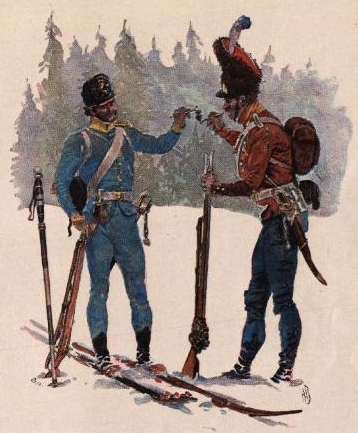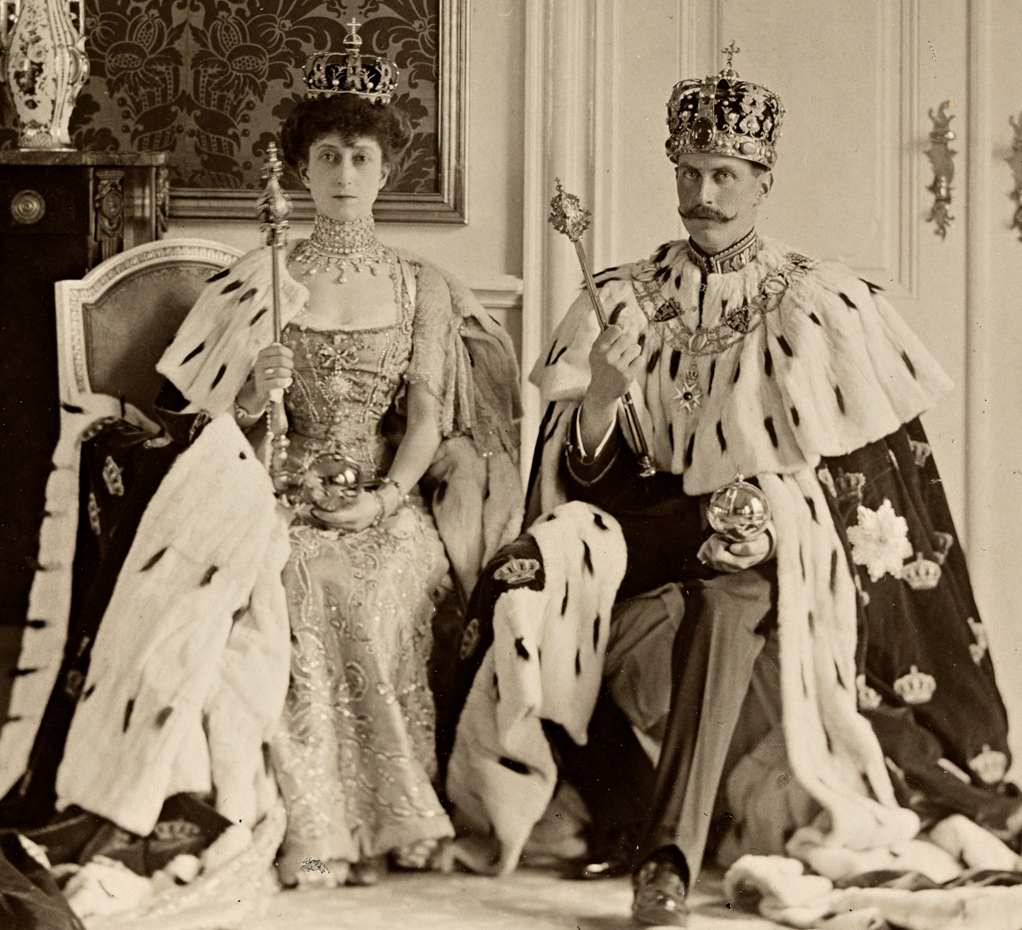|
King Haakon VII Commemorative Medal
The King Haakon VII Commemorative Medal of October 1, 1957 () is a Norwegian award created to commemorate the deceased monarch on the occasion of his funeral. King Haakon's funeral took place on October 1, 1957. The medal ranks 30th in the Norwegian decoration order of precedence. Description The medal is made of gold or silver, and the obverse depicts King Haakon VII. The king is depicted without his crown in an image created by the engraver Ivar Throndsen.H. M. Kong Haakon VII's erindringsmedalje med spenne 1. oktober 1957. 1960. ''Nordisk Numismatisk Unions Medlemsblad'' 10: 199. The portrait is surrounded by the inscription "HAAKON • VII • NORGES • KONGE •" (Haakon VII King of Norway). The reverse shows the royal monogram. The medal is fitted to a royal crown and hangs from a red medal ribbon. The medal ribbon has a silver clasp reading "1. OKTOBER 1957" (October 1, 1957).Hallberg, Harald. 2012. ''Norske dekorasjoner. Tildelt med bånd til å bæres på uniform ell ... [...More Info...] [...Related Items...] OR: [Wikipedia] [Google] [Baidu] |
Royal House Centennial Medal
The Royal House Centennial Medal () is a Norwegian award established by Harald V of Norway to commemorate the centennial of the Norwegian royal family. The day that it was established marks the hundredth anniversary of the day that Haakon VII arrived in Norway: November 25, 1905. The medal ranks 29th in the Norwegian decoration order of precedence. Description The Royal House Centennial Medal is made of silver. It is round and has a diameter of 30 cm, with a royal crown fixed to the top. The obverse depicts King Haakon VII with the inscription "KONGEHUSET 100 ÅR" (The Royal House 100 Years). The reverse shows a wreath made of oak leaves. Above the wreath is the inscription "ALT FOR NORGE" (Everything for Norway), the motto of King Haakon VII, King Olav V, and King Harald V. Below the wreath is the inscription "1905–2005." The medal hangs from a blue ribbon with red and white edges, representing the colors of the Norwegian flag. The same color arrangement was used for t ... [...More Info...] [...Related Items...] OR: [Wikipedia] [Google] [Baidu] |
King Haakon VII 1905–1930 Jubilee Medal
The King Haakon VII 1905–1930 Jubilee Medal (), also known as the King's Jubilee Medal (), is a Norwegian award instituted in 1930 by Haakon VII of Norway in honor of the 25th anniversary of his accession to the throne. The medal has been conferred upon 397 people.Hallberg, Harald. 2012. ''Norske dekorasjoner. Tildelt med bånd til å bæres på uniform eller sivilt antrekk.'' Ålgård: Dreyer bok, p. 235. Description The King Haakon VII 1905–1930 Jubilee Medal is made of silver and is 33 mm in diameter. The obverse depicts King Haakon VII with the inscription "HAAKON • VII • NORGES • KONGE •" (Haakon VII King of Norway). The reverse shows the royal monogram. The medal was created by the engraver Ivar Throndsen. The medal is fitted to a royal crown and hangs from a red medal ribbon. The medal ribbon has a silver clasp reading "1905–1930." Later the King Haakon VII 1905–1955 Jubilee Medal (), the King Haakon VII Commemorative Medal The King Haakon VII Co ... [...More Info...] [...Related Items...] OR: [Wikipedia] [Google] [Baidu] |
Orders, Decorations, And Medals Of Norway
This is a list of Norwegian orders and medals in order of precedence. This list contains all medals approved for wearing on a Norwegian military uniform in ranked order. Group 1: Awarded by or approved by H.M. The King Those awards presented by or approved by the Monarchy of Norway, King of Norway are worn in an order of precedence established by Royal Decree of 11 June 1943, with subsequent additions. Royal Family Orders * Royal Family Order of Haakon VII of Norway, Royal Family Order of King Haakon VII of Norway (1906–1957) * Royal Family Order of Olav V of Norway, Royal Family Order of King Olav V of Norway (1957–1991) * Royal Family Order of Harald V of Norway, Royal Family Order of King Harald V of Norway (1991–current) These are not worn on military uniform. Group 2: Foreign state decorations Decorations that are awarded or approved by foreign heads of state. They are ranked as follows: British, Danish, Finnish, Icelandic, Swedish, other countries are ranked ... [...More Info...] [...Related Items...] OR: [Wikipedia] [Google] [Baidu] |
Haakon VII Of Norway
Haakon VII (; 3 August 187221 September 1957) was King of Norway from 18 November 1905 until his death in 1957. The future Haakon VII was born in Copenhagen as Prince Carl of Denmark. He was the second son of the Crown Prince and Crown Princess of Denmark (later King Frederick VIII and Queen Louise). Prince Carl was educated at the Royal Danish Naval Academy and served in the Royal Danish Navy. After the 1905 dissolution of the union between Sweden and Norway, he was offered the Norwegian crown. Following a November plebiscite, he accepted the offer and was formally elected king of Norway by the Storting. He took the Old Norse name ''Haakon'' and ascended the throne as Haakon VII, becoming the first independent Norwegian monarch since Olaf II in 1387. As king, Haakon gained much sympathy from the Norwegian people. Although the Constitution of Norway vests the King with considerable executive powers, in practice Haakon confined himself to a representative and ceremonial rol ... [...More Info...] [...Related Items...] OR: [Wikipedia] [Google] [Baidu] |
Ivar Throndsen
Ivar Throndsen (March 29, 1853 – January 18, 1932) was a Norwegian engraver. Throndsen was born in Nes, Akershus. He became an apprentice to the goldsmith Jacob Tostrup in Christiania (now Oslo) in 1870, and at the same time studied at the Norwegian National Academy of Craft and Art Industry under the sculptor Julius Middelthun. He received a job at the Royal Norwegian Mint in Kongsberg in 1879 and, after finishing his studies, started working there in 1880. He produced nearly 500 medals, tokens, and badges during his career. Throndsen died in Kongsberg. His work was catalogued by Ragnar Støren and Hans Holst in 1937. Selected works * H. M. The King's Commemorative Medal * H. M. The King's Gold Medal * South Pole Medal * Norwegian Constitution Day medals, 1884–1920 * 1893 Original Die for the Posthorn Stamp (Roman lettering)HÅNDBOK over NORGES FRIMERKER 1855-1955, Vol. 2. Oslo: Norsk Filatelistforbund, 1966. p. 112 * 1902 Nobel Peace Prize The Nobel Peace Priz ... [...More Info...] [...Related Items...] OR: [Wikipedia] [Google] [Baidu] |
Norwegian Army
The Norwegian Army () is the land warfare service branch of the Norwegian Armed Forces. The Army is the oldest of the Norwegian service branches, established as a modern military organization under the command of the King of Norway in 1628. The Army participated in various continental wars during the 17th, 18th, and 19th centuries as well, both in Norway and abroad, especially in World War II (1939–1945). From December 1951, much of the Norwegian Army was declared for operations as part of Allied Forces Northern Europe, within the NATO Military Command Structure. History Creation of the Norwegian Army After the Kalmar War broke out in 1611, the Christian IV of Denmark, Danish-Norwegian king, Christian IV tried to revive the leidang, with dire results. As the Norwegian peasantry had not been armed or trained in the use of arms for nearly three centuries, they were not able to fight. The soldiers deserted or were captured. The soldiers had to participate in military drills w ... [...More Info...] [...Related Items...] OR: [Wikipedia] [Google] [Baidu] |
Royal Norwegian Navy
The Royal Norwegian Navy () is the branch of the Norwegian Armed Forces responsible for navy, naval operations of Norway, including those of the Norwegian Coast Guard. , the Royal Norwegian Navy consists of approximately 3,700 personnel (9,450 in mobilized state, 32,000 when fully mobilized) and 70 vessels, including 4 heavy frigates, 6 submarines, 14 patrol boats, 4 Minesweeper (ship), minesweepers, 4 minehunters, 1 mine detection vessel, 4 support vessels and 2 training vessels. This navy has a history dating back to 955. From 1509 to 1814, it formed part of the navy of history of the Danish navy, Denmark-Norway, also referred to as the "Common Fleet". Since 1814, the Royal Norwegian Navy has again existed as a separate navy. In Norwegian, all its naval vessels since 1946 bear the ship prefix ''KNM'', which stands for "Kongelige Norske Marine" (which translates to "Royal Norwegian Navy"); in English, these vessels are identified by the prefix ''HNoMS'', meaning "His/Her Norweg ... [...More Info...] [...Related Items...] OR: [Wikipedia] [Google] [Baidu] |
Royal Norwegian Air Force
The Royal Norwegian Air Force (RNoAF) () is the air force of Norway. It was established as a separate arm of the Norwegian Armed Forces on 10 November 1944. The RNoAF's peacetime establishment is approximately 2,430 employees (officers, enlisted staff and civilians). 600 personnel also serve their draft period in the RNoAF. After mobilization, the RNoAF would consist of approximately 5,500 personnel. The infrastructure of the RNoAF includes seven airbases (at Ørland Main Air Station, Ørland, Rygge Air Station, Rygge, Andøya Air Station, Andøya, Evenes Air Station, Evenes, Bardufoss Air Station, Bardufoss, Bodø Main Air Station, Bodø, and Gardermoen Air Station, Gardermoen). It also has one control and reporting centre (in Sørreisa Municipality) and three training centres: Værnes in Stjørdal Municipality (about northeast of Trondheim (city), Trondheim), Kjevik in Kristiansand Municipality, and at KNM Harald Haarfagre/Hafrsfjord, Madlaleiren in Stavanger Municipality. Hi ... [...More Info...] [...Related Items...] OR: [Wikipedia] [Google] [Baidu] |
Monarchy Of Norway
The Norwegian monarch is the head of state of Norway, which is a constitutional monarchy, constitutional and hereditary monarchy with a parliamentary system. The Norwegian monarchy can trace its line back to the reign of Harald Fairhair and the previous Petty kingdoms of Norway, petty kingdoms which were united to form Norway; it has been in unions with both Sweden and Denmark for long periods. The present monarch is King Harald V, who has reigned since 17 January 1991, succeeding his father, Olav V. The heir apparent is his only son, Crown Prince Haakon, Crown Prince of Norway, Haakon. The crown prince undertakes various public ceremonial functions, as does the king's wife, Queen Sonja. The crown prince also acts as regent in the king's absence. There are several other members of the Norwegian royal family, royal family, including the king's daughter, grandchildren and sister. Since the dissolution of the union between Norway and Sweden and the subsequent election of a Danish ... [...More Info...] [...Related Items...] OR: [Wikipedia] [Google] [Baidu] |
Awards Established In 1957
An award, sometimes called a distinction, is given to a recipient as a token of recognition of excellence in a certain field. When the token is a medal, ribbon or other item designed for wearing, it is known as a decoration. An award may be described by three aspects: 1) to whom it is given to 2) what 3) by whom, all varying according to purpose. The recipient is often awarded to an individual, a student, athlete or representative of a group of people, be it an organisation, a sports team or a whole country. The award item may be a decoration or an insignia suitable for wearing, such as a medal, badge, award pin or rosette. It can also be a token object such as a certificate, diploma, championship belt, trophy or plaque. The award may also be accompanied by a title of honor, and an object of direct cash value, such as prize money or a scholarship. Furthermore, an is an award given, typically in education, that does not confer the recipient(s) a higher standing but is co ... [...More Info...] [...Related Items...] OR: [Wikipedia] [Google] [Baidu] |




